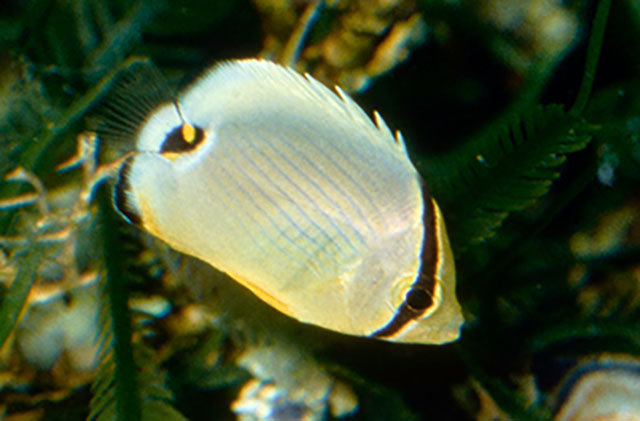Chaetodon
lunulatus
Quoy &
Gaimard,
1825
Oval butterflyfish
View all media / Upload your photos and videos
Expand all
Classification / Names
Teleostei (teleosts) > Acanthuriformes (Surgeonfishes) >
Chaetodontidae (Butterflyfishes)
Etymology: Chaetodon: Greek, chaite = hair + Greek, odous = teeth (Ref. 45335).
More on authors:
Quoy &
Gaimard.
Environment / milieu / depth range / climate zone / distribution range
Marine; reef-associated; depth range 0 - 60 m (Ref. 128797); tropical; 37°N - 32°S95°E - 134°W.
Distribution
Maps

Chaetodon lunulatus / Native range
AquaMaps Data sources:
GBIF
OBIS
This map was computer-generated and has not yet been reviewed.

Chaetodon lunulatus / Suitable habitat
AquaMaps Data sources:
GBIF
OBIS
This map was computer-generated and has not yet been reviewed.

Chaetodon lunulatus / Point map
AquaMaps Data sources:
GBIF
OBIS
This map was computer-generated and has not yet been reviewed.

Chaetodon lunulatus / Year 2050
AquaMaps Data sources:
GBIF
OBIS
This map was computer-generated and has not yet been reviewed.
Length at first maturity / Size / Weight / Age
Short description
Dorsal spines (total): 13 - 14; Dorsal soft rays (total): 20 - 22; Anal spines: 3; Anal soft rays: 18 - 21. Description: Dorsal light pink, shading to yellowish ventrally, stripes diagonal almost horizontal, purple; head yellow, eye bar black with yellow margin; broad black stripe with yellow margin across dorsal, anal and caudal fins; dorsal and anal fins red on outer edge with black margin (Ref. 90102). Distinguished by grey caudal peduncle (Ref. 48636). Snout length 3.0-3.8 in HL. Body depth 1.5-1.8 in SL (Ref. 90102).
Biology
Life cycle and mating behavior
Pairs form upon maturation for breeding purposes (Ref. 56281).
Main reference
Allen, G.R., R. Steene and M. Allen 1998 A guide to angelfishes and butterflyfishes. Odyssey Publishing/Tropical Reef Research. 250 p. (Ref. 47838)
IUCN Red List Status (Ref. 125652)
Least Concern (LC); date assessed: October 07 2009
CITES (Ref. 123416)
Not Evaluated
CMS (Ref. 116361)
Not Evaluated
Threat to humans
Harmless
More information
- Countries
- FAO areas
- Ecosystems
- Occurrences
- Introductions
- Stocks
- Ecology
- Diet
- Food items
- Food consumption
- Ration
- Common names
- Synonyms
- Metabolism
- Predators
- Ecotoxicology
- Reproduction
- Maturity
- Spawning
- Spawning aggregation
- Fecundity
- Eggs
- Egg development
- Age/Size
- Growth
- Length-weight
- Length-length
- Length-frequencies
- Morphometrics
- Morphology
- Larvae
- Larval dynamics
- Recruitment
- Abundance
- References
- Aquaculture
- Aquaculture profile
- Strains
- Genetics
- Allele frequencies
- Heritability
- Diseases
- Processing
- Mass conversion
- Vision
- Pictures
- Stamps, Coins Misc.
- Sounds
- Ciguatera
- Speed
- Swim. type
- Gill area
- Otoliths
- Brains
Estimates based on models
Preferred temperature (Ref. 123201): 24.7 - 29.3, mean 28.3 °C (based on 1779 cells).
Phylogenetic diversity index (Ref. 82804): PD50 = 0.5 [Uniqueness, from 0.5 = low to 2.0 = high].
Bayesian length-weight: a=0.02291 (0.01133 - 0.04632), b=3.00 (2.83 - 3.17), in cm total length, based on LWR estimates for this Genus-body shape (Ref. 93245).
Trophic level (Ref. 69278): 3.3 ±0.6 se; Based on food items.
Resilience (Ref. 120179): High, minimum population doubling time less than 15 months (Preliminary K or Fecundity.).
Fishing vulnerability (Ref. 59153): Low vulnerability (17 of 100).
Nutrients (Ref. 124155): Calcium = 146 [71, 260] mg/100g; Iron = 1.15 [0.64, 2.07] mg/100g; Protein = 18.7 [17.4, 19.9] %; Omega3 = 0.117 [0.060, 0.229] g/100g; Selenium = 44.1 [20.5, 94.6] μg/100g; VitaminA = 30.4 [7.8, 118.9] μg/100g; Zinc = 1.79 [1.12, 2.78] mg/100g (wet weight);










